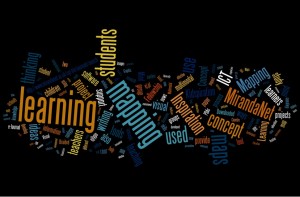The Use of Concept Maps for Collaborative Knowledge Construction
During the past ten years a number of programs have been developed that enable concept maps to be created on computers. Many of these have been used in schools, and they have facilitated the use of mapping as a curriculum tool. The ease of use and other affordances of the programs – colour, the use of images, embedding links, notes and other materials – has enabled users to explore the possibilities of the tool without the limitations imposed by paper-based applications. Recent developments in online concept maps have included collaboration between multiple users, instant communication during the creation of the map through programs such as Skype, and the export of the maps in a range of formats.
The ideas that we wish to explore in this paper are based on the outcomes of research undertaken during MirandaMod iGatherings, (simultaneous virtual and face-to-face debates between professional educators in a global context) held during June and July 2009, and during a roundtable discussion held during a one-day conference on Work-based Learning ay the WLE Centre, Institute of Education, University of London. These focused on the emerging informal processes by which theory can be transformed into practice by education practitioners themselves: the process of ‘praxis’ (Freire, 1970). These igatherings were used to develop the methodology and collect data for this work-based case study, that would serve to inform a further six igatherings to take place between September 2009 and March 2010. (See Appendix One for further details of MirandaMods and iGatherings.)
Multidimensional concept mapping has been used both as a data collection method, and as a medium to stimulate the creation and dissemination of collaborative knowledge within the profession (Preston 2009a, 2009b). The web-based program MindMeister (http://www.mindmeister.com) was used as the vehicle for this study for the creation and dissemination of knowledge, rather than for data collection. However, the findings from this series of igatherings provide research data about the relationship between work-based learning and praxis and new knowledge and practice on concept mapping methodology.
The multiple perspectives from which this data is drawn inform a system for evaluating multimodal concept maps. The analysis of its effectiveness in identifying concept development and the formation of praxis in the context of work-based learning for education professionals will be part of a longer study.
